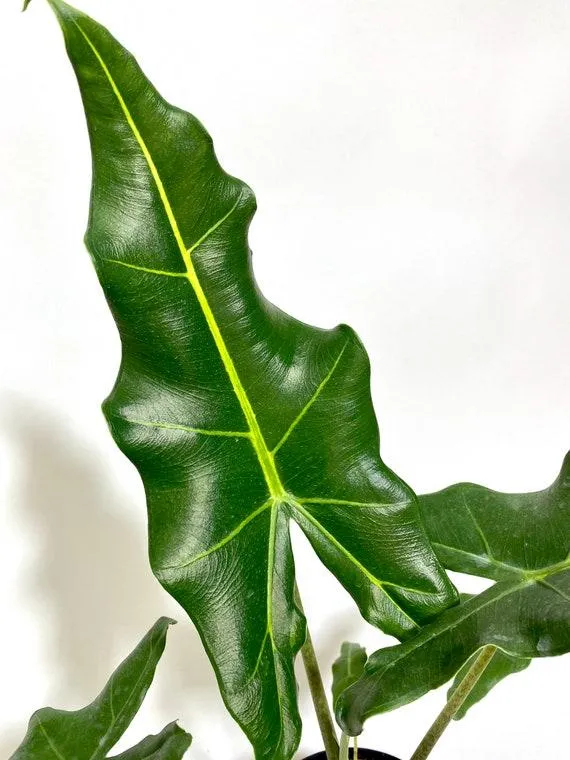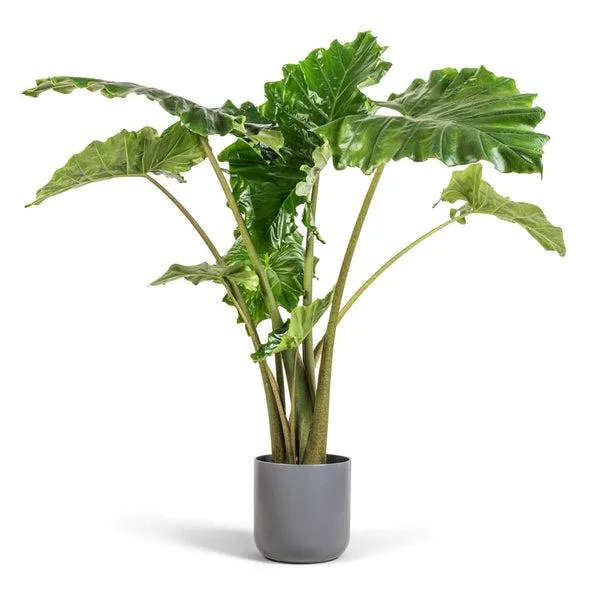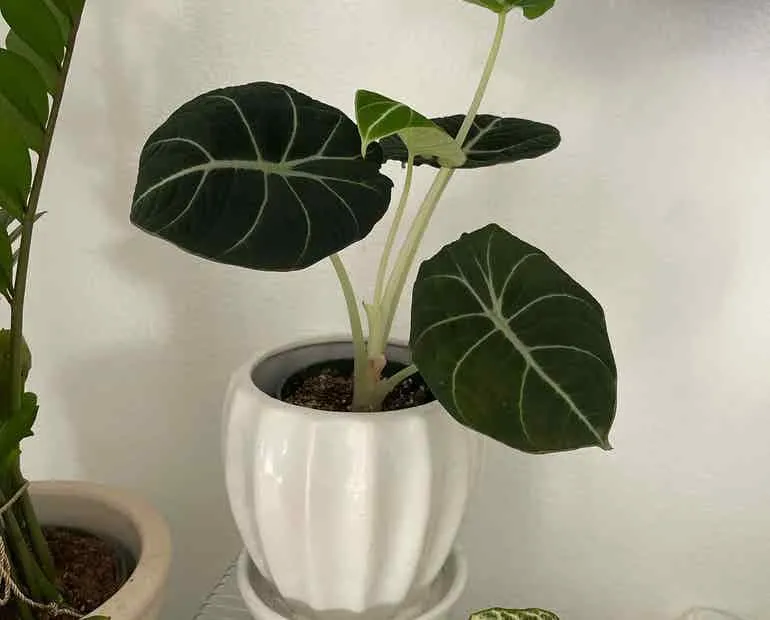Are Alocasia Plants Safe for Cats?
If you’re considering adding an Alocasia plant to your home and want to know if it’s okay to have around cats, you’ve come to the right place. As the owner of three inquisitive felines myself, I understand the importance of only bringing cat-safe plants into your space. In this article, I’ll provide a comprehensive overview of Alocasia toxicity, typical cat behaviors, and tips for plant-proofing to help you determine if this genus is a good fit for your furry friends.
Understanding Alocasia Toxicity
To start, let’s talk about Alocasia toxicity levels. All parts of the Alocasia plant – including the stems, leaves, roots, and sap – contain calcium oxalate crystals. If ingested by cats, these crystals can cause mild to severe irritation to the mouth and digestive tract. From my experience as a veterinary nurse, symptoms may include drooling, vomiting, diarrhea, and loss of appetite. In very rare cases of large ingestions, the crystals could potentially cause kidney damage as well.
So in summary, Alocasia is considered mildly toxic to cats. However, the risks can be minimized through responsible plant parenting. The toxicity really depends on the amount eaten – a nibble here or there is unlikely to cause issues, but deliberate and repeated chewing or ingestion of large pieces could potentially lead to an upset tummy.
Understanding Common Cat Behaviors
Next, it’s important to be aware of how curious cats tend to interact with houseplants. While some felines ignore foliage altogether, many see green leaves or hanging plants as opportune places to rub, scratch, or even occasionally nibble and taste. I’ve found that cats, like toddlers, are often drawn to putting things in their mouths as a way to explore their environment.

Some other behaviors that may bring plants into “paw’s reach” of cats include batting at or pawing hanging leaves, climbing plants for height, or even rolling around and rubbing on foliage. So even if your cat isn’t an avowed plant chomper, coming into contact with leaves and bringing crystals back to the mouth through grooming is a possibility.
Tips for Plant-Proofing Your Home
Given these typical cat tendencies, having Alocasia and other mildly toxic plants requires some preparation and preventive measures:
- Keep plants high out of reach on bookshelves, tall tables, or wall brackets where pets can’t access.
The higher the better! - Use bitter, safe repellents on leaves and soil if kittens or nibblers are a concern. Products made from ingredients like citrus oils and capsaicin help turn plants from tempting to distasteful.
- Watch for any munching or mouthing behaviors and promptly redirect cats to appropriate chew toys instead. Consistency is key for training.
- Consider potting Alocasias in heavy containers that won’t tip over if batted or climbed. Top-heavy or toppling plants pose additional hazards.
- After playing near plants, wipe your cat’s paws and face with a damp cloth in case they picked up crystals that could transfer to grooming.
With diligent plant placement out of reach, using deterrents when needed, and cleaning up properly after play sessions near plants, it’s certainly possible to have Alocasia and feline friends coexist harmoniously in the home. In my experience, a little preparation goes a long way towards peacefully plant-proofing.
Some Final Considerations
Of course, every cat is an individual – some may never touch plants while others remain relentlessly curious. If you have an avid plant muncher, it’s best to choose non-toxic options instead of taking risks. Alocasia’s mild toxicity also means that if a bite does occur, it’s smart to monitor your cat and contact your vet if any concerning symptoms arise.

It’s also important to consider how much supervision you can provide based on your schedule and the size of your plants. Bigger specimens are less practical and pose more hazards than tabletop sized pots you can easily move out of reach when unattended. Basically, for cats and kids alike – babyproofing is key!
With the right precautions and set up, Alocasia could work for most homes with cats. But you know your furry friends best. If they seem like natural plant pesto connoisseurs, steering clear or using bitter sprays is likely the safer route. Overall though, there are definitely situations where these beauties can coexist peacefully next to feline family members – it’s just a matter of understanding risks and taking proper precautions.
I hope this overview has helped provide some clarity on whether Alocasia plants may be a good fit based on your cat’s personality and behaviors. Please let me know if you have any other questions! With knowledge and preparation, many “toxic” plants can work well even in multi-species households. Safe plant-ing!
Important Facts About Keeping Alocasia Plants Cat Friendly
| Plant | Toxicity Level | Symptoms if Ingested | Cat Deterrent Tips |
|---|---|---|---|
| Polly | Low | Mild upset stomach | Place out of reach, use spray bottle |
| Hawaiian Pau Orange | Low | Mild upset stomach | Cover soil with rocks, place high up |
| Alocasia Lauterbachiana | Low | Mild upset stomach | Place behind barrier, use citrus scents |
| Alocasia macrorrhiza | Low | Mild upset stomach | Use top heavy pot, spray leaves with bitter spray |
| Zebrina | Low | Mild upset stomach | Cover soil when away, place out of paths |
FAQ
-
Is an alocasia plant unsafe for cats?
Basically, alocasia plants are not ideal to have around cats. Their sap can cause irritation to a cat’s mouth and make them feel sick if they chew on the leaves. So it’s better to keep aloaciasia plants high up or in another room where cats can’t reach them.

-
What happens if a cat eats an alocasia leaf?
If a curious cat chomps down on an alocasia leaf, it may possibly experience some discomfort. The sap contains needle-like calcium oxalate crystals which can irritate a cat’s tongue and mouth. At the same time, there are no reports of alocasia leaves being seriously toxic to cats. Seems like most kitties learn to avoid them after one unpleasant taste!
-
Can an alocasia plant be poisonous to cats?
While alocasia leaves are not considered highly venomous per se, the calcium oxalate in the plant sap can potentially cause some issues for cats. Issues may include excessive drooling, mouth irritation, and possibly diarrhea or vomiting. Nevertheless, it would take a lot of leaf material to truly endanger a cat. So in moderation an alocasia exposure is unlikely to truly harm a feline.
-
What precautions should be taken with cats and alocasia?
It’s advisable to take precautions with aloaciasia plants and cats. Maybe place the plant high up on a shelf or tall table to deter kitty chewing. You can also use a plastic pot with drainage holes too small for little paws to poke through. Appears the best bet is to simply keep plant and pet apart whenever possible to basically avoid any tummy troubles for Fluffy!
-
Can alocasia plants cause long term issues for cats?
Most experts say alocasia plant exposure poses little long term risk to cats. I mean, unless a cat is constantly noshing on leaves for weeks, there shouldn’t be lasting consequences. Does chewing one leaf really amount to much in the grand scheme of things? Probably not. The calcium oxalate crystals may irritate kitty’s mouth but clearance should occur within hours. However, giving aloaciasia regular access seems misguided. Is that fair?

In summary, while alocasia plants are not classified as highly toxic to cats, they contain elements that can discomfort curious felines. The safest approach is preventing mouth access whenever possible through placement or using barriers. With moderation, limited contact is unlikely to cause issues. Ultimately, cat owners must weigh the visual appeal of keeping these popular houseplants versus potential risks to curious companions. What do you think – do the benefits outweigh the concerns in your situation? I’d love to hear other perspectives on this issue!
